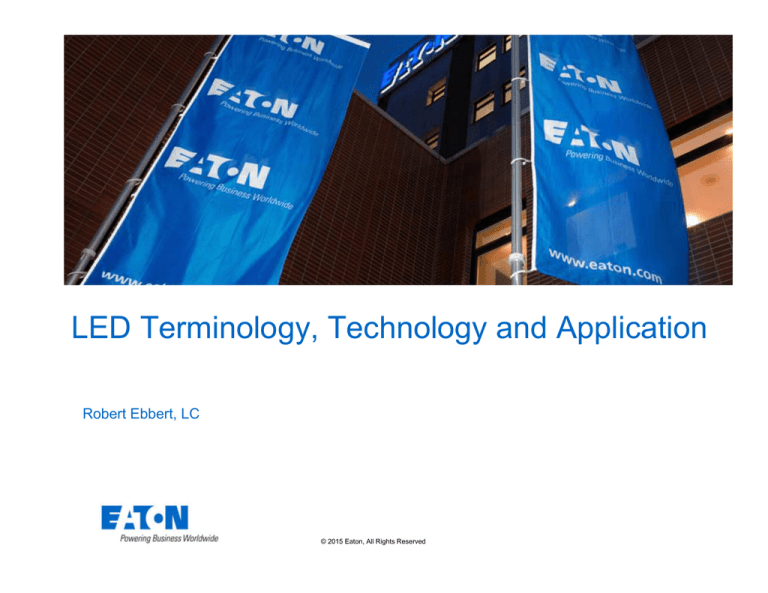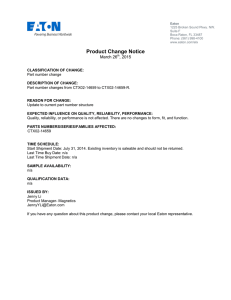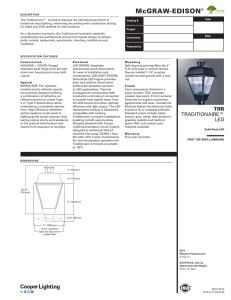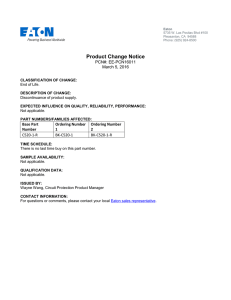
LED Terminology, Technology and Application
Robert Ebbert, LC
© 2015 Eaton, All Rights Reserved.
A History of Light Sources
•
•
•
•
•
•
•
•
•
•
•
•
•
~400,000 BCE - Fire is discovered.
~3000 BCE - Oil lamps are open bowls with a spout to hold the wick.
~400 - The candle is invented.
1809 - Sir Humphrey Davey demonstrates electrical discharge lighting to
the Royal Institution in London, using an open-air arc between two carbon
rods. The result is a very intense, and very pure white light. Unfortunately,
as the arc runs, carbon boils off and the rods wear away: constant attention
must be paid to readjusting the arc, feeding more carbon in.
1841 - Frederick DeMoleyns patented incandescent lamp using filaments of
platinum and carbon, protected by a vacuum.
1880 - Thomas Edison receives U.S. patent #223,898 for the carbon
filament incandescent lamp.
1932 - Low pressure sodium lamps are first used commercially.
1934 - The high-pressure mercury lamp is introduced.
1938 - First commercial sale of the fluorescent lamp
1957 - The quartz halogen lamp (A.K.A. tungsten halogen lamp) is
invented. In conventional tungsten lamps, the filament metal slowly
evaporates and condenses on the glass envelope, leaving a black stain. In
this case, the halogen removes the deposited tungsten and puts it back on
the filament.
1962 - First light emitting diode (LED)
1966 - Commercial introduction of the high pressure sodium lamp
1969 - A new form of metal halide lamp, the HMI lamp (mercury medium
arc iodides) is introduced. The H stands for mercury (atomic symbol "Hg"),
M is for Metals and the I is for halogen components (iodide, bromide). It
provides a daylight type spectrum.
© 2015 Eaton, All Rights Reserved.
2
Life Rating of Light Source
Note regarding life ratings: • Life for HID is calculated when 50% of lamps are burned out.
• Life for LED is calculated via IESNA TM‐21, limits life claim to 6 x the number of hours tested. Typical is 60,000, life is then given as the lumen depreciation estimated at that life number. For example, L9060,000 is 90% lumen depreciation at 60,000 hours.
© 2015 Eaton, All Rights Reserved.
3
Overview of Sources
BLUE COLOR
LIFE: 24,000 RATED
9,600 MEAN
EFFICACY: 50~60 LPW
CCT: 5700K
CRI: 15
WHITE COLOR
LIFE: 16,000 RATED
6,400 MEAN
EFFICACY: 80~100 LPW
CCT: 4000K~5000K
CRI: 60~70
YELLOW COLOR
LIFE: 24,000 RATED
12,000 MEAN
EFFICACY: 100~120 LPW
CCT: 2000K
CRI: 15~25
WHITE COLOR
LIFE: 24,000 RATED
9,600 MEAN
EFFICACY: 100~120 LPW
CCT: 3500K~4100K
CRI: 80~90
© 2015 Eaton, All Rights Reserved.
WHITE – ANY COLOR
AVAILABLE
LIFE: 350,000 RATED
60,000 MEAN
EFFICACY: 60~110 LPW
CCT: 3000K~6000K
CRI: 65~85
PRICE: $-$$$
4
4
Induction Lighting
Opportunities
Threats
Low price points compared to LED driving
"second look“
Additional awareness of maintenance costs
160
$100
•Efficiency
140
$90
$80
120
$70
100
$60
80
$50
60
$40
$30
40
•Cost
20
$20
•Cost ($/kilolumen)
•Efficacy (lumens/watt)
LED might obsolete
$10
$0
0
2007
2012
2017
•Source: DOE Report “Energy Savings Potential of SSL in General Illumination Applications (High CRI)– Dec 2006”
Strengths
100,000 Hour Life (50% mortality)
Instant Start and Re-Strike
System 80-90 Lumens per Watt
Excellent Lumen Maintenance
100% Flicker Free
Excellent CRI – 80-95
Weaknesses
Thermal Management with retrofits
Poor or limited optical control due to size of lamp,
Generally not dimmable
Limited lumen packages
Not a strong track record for reliability
Requires mercury to operate
Light output varies with operating temperature.
Low delivered lumens per watt
•Interesting technology, but limitations have depressed adoption
© 2015 Eaton, All Rights Reserved.
5
LED vs Induction
40’ Grid
Right
25’ MH
.
.
Street
Street
Left
165 watt Induction luminaire (180 total
watts)Type 3 Short with 8414 delivered
lumens, 47 lumens per watt. Light
behind the pole for over 40’.
LED with Type 2 optic, 9294 lumens (92
watts), 101 delivered lumens per watt
with light evenly dispersed 10’ to 30’
behind the luminaire for sidewalk
illumination.
© 2015 Eaton, All Rights Reserved.
Plasma Lighting
Opportunities
Threats
LED price points forcing
examination of alternate
technology
160
$100
•Efficiency
140
$90
$80
120
$70
100
$60
80
$50
60
$40
$30
40
•Cost
20
$20
•Cost ($/kilolumen)
•Efficacy (lumens/watt)
LED might obsolete
$10
$0
0
2007
2012
2017
•Source: DOE Report “Energy Savings Potential of SSL in General Illumination Applications (High CRI)– Dec 2006”
Strengths
Weaknesses
Quick Start and Re-Strike
Excellent CRI ~ 80
Purported to have Long Life
Relatively inefficient source (~50-80 LPW
@ Source)
Thermal Management with retrofits
Lifetimes of electrical components suspect
Optical control in Outdoor asymmetric
applications a challenge
•Interesting Source, but may be too late to Market
© 2015 Eaton, All Rights Reserved.
7
LED Luminaire and Component Testing
Reliability System Testing
•
Humidity
•
Salt Spray
•
Water IPX6
•
Dust IP6X
•
Vibration testing
•
UV testing
•
Thermal testing on luminaires at -30°C (-30°F) degree
to 40°C(104°F) standard, -40°C to 50°C for certain
models.
•
Thermal testing on components from -40°C to 90°C
•
Require UL accredited test laboratory and NVLAP
accredited Photometrics laboratory.
•
DOE approved Lighting Facts Test Laboratory
partner
© 2015 Eaton, All Rights Reserved.
8
Thermal Test Information
At right is a sample
thermal test report on an
outdoor LED luminaire.
Note readings are taken
on many parts of the
luminaire including the
LED case, driver and
surge module.
© 2015 Eaton, All Rights Reserved.
9
Absolute and Relative Photometry
Absolute Photometry
LED luminaires LM-79-08
Lamps integral to luminaire
No lamp seasoning,
calibrated to lamp of known
output
Actual lumen output
measured
Unique results for each
product
Relative Photometry
Bare lamps measured separately.
•
•
•
Seasoned (aged) lamps
Output stabilization
Raw output measured
Luminaire test
•
•
•
Same lamps and ballast
Identical electrical and thermal
characteristics
Results scaled to initial rated lamp
lumens
Same results with
different lamps
© 2015 Eaton, All Rights Reserved.
10
Photometric Testing per IES LM-79-08
Electrical and Photometric Measurements of SolidState Lighting Products
– Luminaire based absolute photometry
• Total Luminous Flux
• Luminous Intensity Distribution
• Electrical Power
• Luminous Efficacy (LPW - calculated)
• Color Characteristics
• Chromaticity
• CCT
• CRI
Integrating Sphere
© 2015 Eaton, All Rights Reserved.
11
Integrating Sphere Report
© 2015 Eaton, All Rights Reserved.
12
Quality of Light
High Pressure Sodium
(2000K)
Metal Halide (Quartz, Ceramic,
Moonlight) ~4000K
COLD LED (6000-6500K)
4000K, 70 CRI is becoming an industry standard for the majority of
outdoor applications.
© 2015 Eaton, All Rights Reserved.
13
Measuring Luminaire Performance
Goniophotometer
An apparatus for measuring
the directional light
distribution characteristics of
light sources, luminaires,
media, and surfaces.
PLAN VIEW
Luminaire
Indirect
Light
Shield
Photocell
Mirror
© 2015 Eaton, All Rights Reserved.
14
Absolute IES file information from Goniophotometer
© 2015 Eaton, All Rights Reserved.
15
Luminaire Classification System
Backlight Up-light Glare
180°
UH
100°
100°
UL
90°
80°
90°
FVH
BVH
80°
BH
FH
60°
60°
BM
30°
FM
BL
FL
0°
30°
Zonal distribution of the fixture are broken up into 10 distinct
sections.
Values are often in terms of a percentage of overall lamp lumens.
Any one rating is determined by the maximum rating obtained for
that table. For example, if the BH zone is rated B1, the BM zone is
rated B2, and the BL zone is rated B1, then the backlight rating for
the luminaire is B2.
© 2015 Eaton, All Rights Reserved.
16
UV stabilizers greatly reduce the rate of yellowing on plastic materials
Require UV stabilizers on all optical materials
Control
UV Treated
© 2015 Eaton, All Rights Reserved.
17
Class 2 LED Driver
LED
luminaires
with Class
2 drivers
can use an
acrylic
lens.
© 2015 Eaton, All Rights Reserved.
18
Class 1 LED Driver
Class 1 LED
luminaires will
have a glass or
polycarbonate
lens
© 2015 Eaton, All Rights Reserved.
19
Superior thermal management results in long life
The above driver data sheet indicates that the driver lifetime is
100,000 hours with a Tcase operating temperature of 75C or
lower. The following thermal report had a Tcase temperature of
56°C when operating in a 40°C ambient environment.
© 2015 Eaton, All Rights Reserved.
20
Thermal report to confirm driver and LED operating temperature at 40°C ambient
The above 40C thermal report shows the driver running at 56C. Per the driver
specification sheet on the previous slide the driver should last 100,000 hours at this
temperature without a disabling electrical surge.
© 2015 Eaton, All Rights Reserved.
21
Surge protection is also essential for driver life
•
Magnetic ballast designs tend to meet 7 kV or 10kV BIL requirements
• not uncommon to see 10kV to 15 kV or more capability
• ANSI C82.6 Mandates 10kV for Roadway Application, 6kV for all other
Outdoor Applications.
•
Electronic Drivers tend to meet a 2-4kV BIL
•
fine for many applications
•
far more susceptible to lighting strike induced transients than magnetic.
... Unless very specific provisions have been incorporated in their
design
© 2015 Eaton, All Rights Reserved.
22
Make sure the SPD meets UL1449
© 2015 Eaton, All Rights Reserved.
23
UL1449 Surge Protector Label Deciphered
This information is required on the label of a UL 1449 Surge Protective Device
Ratings: max nominal voltage, frequency and line current
that the product is rated for. These are the nominal operating
conditions under which the surge protector will essentially do
nothing.
ln =3kA: this is the current magnitude used to evaluate the
product. Each protection mode (line-neutral, line-ground, neutralground) is surged 15 times at this 3kA current.
Type 2 – UL surge protector designation. Type 2 is defined as a
permanently connected surge protector installed after the main
disconnect or circuit breaker (in other words, installed in the fixture as
opposed to on the panel).
MLV: Measured Limiting Voltage. This is the voltage
measured for each mode (line-neutral, line-ground,
neutral-ground) during the 3kA surge tests described
above. In other words, this was the voltage needed to drive
a 3kA surge for each mode. Essentially it documents what
took place during the 3kA surge test.
MCOV: Max Continuous Operating Voltage. This is the voltage below which the
surge protector doesn’t do anything. It is generally about 15-20% higher than the
nominal rated voltage (347V) in order to accommodate small fluctuations in
operating voltage. Above MCOV (in this case, 420V), the surge protector starts
shunting current across the mode (line-neutral, line-ground, neutral-ground)
instead of allowing it into the fixture. Once this starts, the surge protector will
begin to suffer damage. Instantaneous spikes do little damage, but
sustained over-voltage conditions will cause permanent damage to the surge
protector until it fails, at which point the fixture will not operate until the surge
protector is replaced.
Surge modules available in series or parallel configurations with up to
20kV/20kA protection
© 2015 Eaton, All Rights Reserved.
24
Surge Protector – What to Look For
Does not display a UL or CSA
marking; non-compliance with
Article 285.5
Does not describe short circuit
current rating; non-compliance
with Article 285.6
Does not incorporate fusing
such that SPD becomes
disconnected after MOV failure;
non-compliance with Article
285.27
May not be 14AWG Wires;
possible non-compliance with
Article 285.26
Insufficient protection will reduce fixture life.
© 2015 Eaton, All Rights Reserved.
25
IESNA LM-80 Test Report summary page
Luminous flux depreciation
information
After 10,000 hours of testing this LED has actually increased at the 85°C and 105°C case
temperatures with only a .0006 decrease at 55°C case temperature
© 2015 Eaton, All Rights Reserved.
26
IESNA LM-80 Test Report summary page
Color or kelvin temperature shift
information
In-situ case operating temperature of 86°C the NVN LED at 25C ambient at 86°C shows
minimal color shift over the 10,000 hour test period.
© 2015 Eaton, All Rights Reserved.
27
TM-21-11
•
LM-80 -- only an LED testing standard
•
IES TM-21-11 -- mathematical framework for LM-80 data and making
useful LED lifetime projections
Key points of TM-21:
•
Developed by major LED suppliers with support of NIST, PNNL
•
Projection limited to 6x the available LM-80 data set
•
Projection algorithm: least squares fit to the data set
•
L70, L80, L90, Lxx projections easily possible
•
Nomenclature: Lp(Yk)where p is Lumen Maintenance percentage and Y
is length of LM-80 data set in thousands of hours ie: L85(10k)
© 2015 Eaton, All Rights Reserved.
28
TM-21 – Use the latest data
Initial data variability (i.e. “hump”) is
difficult for models to evaluate (0-1000 hr)
Later data exhibits more characteristic
decay curve of interest
• Non-chip decay (encapsulant, etc.) occurs
early and with varying effects on decay curve
• Later decay is chip-driven and relatively
consistent with exponential curve
• Verification with long duration data sets
(>10,000 hr) shows better model to reality
fit with last 5,000 hours of 10,000 hour data
For 6,000 hours of data (LM-80 minimum)
and up to 10,000 hours: Use last 5,000 hours
For > 10,000 hours: Use the last ½ of the
collected data
© 2015 Eaton, All Rights Reserved.
29
Energy Star TM-21 Report
Displays lumen maintenance of the LED in the luminaire at a selected ambient
temperature over a specific period of time.
This TM-21 report shows
95% lumen maintenance at
60,000 hours in a 40C
ambient environment with
10,000 hours of LM-80 data.
© 2015 Eaton, All Rights Reserved.
30
Drive Current, What is it?
LuxeonTX
HP
MPG
Efficacy
LPW
Drive
Current
Vf
Watts
Lumen
Output
350mA
2.71V
.95
147
155
700mA
2.80V
1.96
269
137
1050mA
2.86V
3.00
360
136
The harder you drive an LED the less efficient it is, but remember the Prius
in not necessarily going to “last” longer than the Porsche.
408 HP 17 MPG / 0-60MPH 3.7 sec.
134 HP 50 MPG / 0-60 MPH 11 sec.
© 2015 Eaton, All Rights Reserved.
31
Drive current and fixture specification
•
Each LED package has different maximum current and junction temperature specifications.
•
The drive current that pushes one past its thermal limits may be well within another’s
operating limits.
•
Managing the thermal load is key to operating an LED within its performance limits.
• An LED that is properly heatsinked can withstand higher drive currents.
• The key is to draw heat away from the LED junction so that it reaches thermal
equilibrium below its max allowable temperature.
•
Lighting should be specified around the performance needs of the end user (luminance,
illuminance, efficacy, etc.), not its internal design.
© 2015 Eaton, All Rights Reserved.
32
3
LED Comparison
3.2W
5.8W
61W
•
The LED on the left is from a Navion.
• Voltage = 3V Drive Current = 1.05A, Wattage = 3.2W.
•
The LED in the middle is from a Caretaker.
• Voltage = 145V Drive Current = 0.04A, Wattage = 5.8W
•
The LED on the right is from a Verdeon.
• Voltage = 34V Drive Current = 1.8A, Wattage = 61W
Question: Which one is running at the best drive current?
© 2015 Eaton, All Rights Reserved.
33
LED Comparison
3.2W
5.8W
61W
Answer: Each is running at the correct drive current for its application.
•
1-Square Navion
• 16 LEDs @ 3.2W each
• Total wattage = 51W
• Case temperature of LEDs < 85oC, within mfr specs
•
Caretaker
• 8 LEDs @ 5.8W each
• Total wattage = 46W
• Case temperature of LEDs < 85oC, within mfr specs
•
Verdeon A01
• 1 LED @ 61W
• Total wattage = 61W
• Case temperature of LEDs < 100oC, within mfr specs
© 2015 Eaton, All Rights Reserved.
34
What Determines Life?
Heat = Life
An LED driven at 1050mA with a Tc (case temperature) of 85C
will outlive the same LED driven at 530mA with a Tc of 90C
Life = Tc
Drive Current = Efficiency
© 2015 Eaton, All Rights Reserved.
35
Why you should not specify by lumens per watt
Same source, same ballast, different performance
150 WATTS
150 WATTS
25’
85 Lumens per Watt
67 Lumens per Watt
0.46 Average Illuminance
0.93 Average Illuminance
Why the “lumens per watt method” of calculating lighting fixture performance alone does not
equate to energy efficiency.
Although the luminaire on the left is 27% higher in fixture LPW, it produces less than half the
average illumination on the ground
To give the same illumination as the lower LPW fixtures, over twice as many of the higher
LPW fixtures would be needed, resulting in a net energy increase of 102%
© 2015 Eaton, All Rights Reserved.
36
Where is the light going?
Three dimension rendering of light distributions and relative footcandles on ground
High LWP post top on left, lower LPW shoebox on right
© 2015 Eaton, All Rights Reserved.
37
Luminaire Dirt Depreciation
Dirt, dust, dead bugs and
water collect inside this
HID luminaire lens in
Boston, MA
How much light
is really passing
through the lens?
© 2015 Eaton, All Rights Reserved.
38
HID │LED LIGHT LOSS FACTORS
HID (High Pressure Sodium)
vs.
LED
LED Type 3 distribution
HID Type 3 distribution
LLF = BF * LDD * LLD
Ballast Factor
Luminaire Dirt Depreciation
1.0
0.90
Ballast Factor
Luminaire Dirt Depreciation
1.0
0.95
(IP66 optical chamber)
LLD (Lamp Lumen Depreciation)
0.90
LLD = Mean Lumens (@ 50% of lamp life)
/ Initial Lumens (12,000 hours)
LLF = 0.9 * 0.90 = 0.81
LLD (Lamp Lumen Depreciation)
0.96
LLD = Mean Lumens (@ ~60,000 hrs) /
Initial Lumens
LLF = 0.95 * 0.96 = 0.91
© 2015 Eaton, All Rights Reserved.
39 39
HID │LED Equivalency
HID
vs.
OVX Type 3 distribution
250W HPS Lamp
LED
LED Type 3 distribution
28,000 lumens
110 watt LED
10,567 lumens
70% Total Downward
Luminaire Efficiency
19,600 lumens
100% Total
Downward Luminaire
Efficiency
10,567 lumens
Street Side Lumens
(52.7%)
10,329 lumens
(300 ballast watts)
X 0.81 LLF
=
8,366 lumens
Street Side Lumens
(82%)
X 0.91 LLF
8,660 lumens
=
7,880 lumens
~6% less street side lumens after 5X the
operating hours
© 2015 Eaton, All Rights Reserved.
40 40
300 ballast watts
LED type 2 vs HID Flat Glass 250 watt HPS Type 3
cobrahead
24’ roadway, 2’ setback, 25’ mounting height, 4’ sweep arm, 145’ spacing
Illuminance Comparison
LED
•
•
I
I
•
•
Red line = .1 FC
110 watts, 10,308 initial delivered
lumens, 8,774 downward street
side lumens
.912 Light Loss Factor (60,000
hours)
1.61 average, .42 minimum, 3.56
maximum, 3.83 to 1 ave/min.
Max Lv Ratio .33 on R3 pavement
Green line = .5 FC
HID
•
I
I
•
•
When lighting 2 to 3 lane roadways, type 2
distribution patterns will concentrate more light on
the roadway than type 3 distribution patterns.
© 2015 Eaton, All Rights Reserved.
•
300 watts, 22,120 initial delivered
lumens, 15,272 downward street
side lumens
.81 Light Loss Factor (12,000
hours)
2.88 average, .37 minimum, 9.86
maximum, 7.78 to 1 ave/min.
Max Lv Ratio .35 on R3 pavement
43
LED Type 2 vs LED type 2
34’ mounting height, 8’ setback with 8’ arms
LED Luminaire 1
•
•
I
I
•
149’ pole spacing for a 1.01 FC average
•
•
154 watts, 11,136 initial delivered
lumens, 8,733 downward street
side lumens
.85 Light Loss Factor (60,000
+hrs)
1.01 average, .84 minimum, 1.21
maximum, 1.20 to 1 ave/min.
Rear spill light 25’, forward spill
light 46’
Max Lv Ratio .26 on R3 pavement
LED Luminaire 2
•
I
I
•
•
155’ pole spacing for a 1 FC average
•
LED on top has shorter pole spacing while using
more watts due to less light on task (roadway).
•
© 2015 Eaton, All Rights Reserved.
110 watts, 9,817 initial delivered
lumens, 8,356 downward street
side lumens
.85 Light Loss Factor (60,000+
hrs)
1.0 average, .56 minimum, 1.66
maximum, 1.79 to 1 ave/min.
Rear spill light 25’, forward spill
light 38’
Max Lv Ratio .23 on R3 pavement
44
Existing Atlanta roadway lighting with 150 HPS drop glass cobra head
Would you feel safe walking in this neighborhood at night?
2000K, 20CRI
light source
with poor
optical
distribution
HID luminaires at the intersection in the foreground are contributing to light level at the bottom of the picture.
© 2015 Eaton, All Rights Reserved.
45
Newly installed LED luminaires with over optic lens provides a visibly superior night
environment for the residents of this Atlanta neighborhood.
4000K with ~73
CRI with the
provides
higher
luminance
levels on the
roadway and
sidewalks with
51% less
energy
Luminance =
The amount
of light
reflected off
the roadway
or sidewalk
Verdeon luminaires at the intersection in the foreground are contributing to light level at the bottom of the picture.
© 2015 Eaton, All Rights Reserved.
46
External Shields
Field installed LED shield
© 2015 Eaton, All Rights Reserved.
47
Optical Control Advantage Over External Shields
40’ Grid
25’ MH
.
.
Street
Type 2 Short , 7928
lumens, 78 lumens
per watt, with light
more than 40’ behind
the pole.
Street
.
Street
Type 2 Short with an external Type 2 Medium internal control
shield, 6090 lumens, 60
optics, 7523 lumens, 105 lumens
lumens per watt, light
per watt with light evenly
reduced to 20’ behind the
dispersed 10’ to 20’ behind the
pole.
pole for sidewalk illumination.
External shields can reduce luminaire efficiency by as much as 23%.
precision optics maintain luminaire efficiency by re-directing the light
evenly along the roadway.
© 2015 Eaton, All Rights Reserved.
48
The poor optical control of the existing HID shoebox luminaires does a poor
job of directing light into the second row of trucks at this auto dealership
Superior light control with higher CRI produces
better results with less total lumens and watts.
Why field rotatable optics on a roadway fixture?
Light both roadways and the intersection from a single pole.
50% of optics rotated 90
degrees. 35’ mounting
height, 10’ arm.
Intersection and over 170’
of roadway illuminated in
both directions by a
single luminaire using
only 110 watts.
26’ Wide Road
.
Type 2 beam pattern
shown with the
luminaire delivering
~10,000 total lumens.
© 2015 Eaton, All Rights Reserved.
51
New optical technology blocks the line of sight of the LED light source
from the observer reducing glare while delivering 90 lumens per watt.
© 2015 Eaton, All Rights Reserved.
52
Questions?
© 2013 Eaton. All rights reserved.
53



